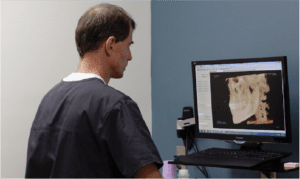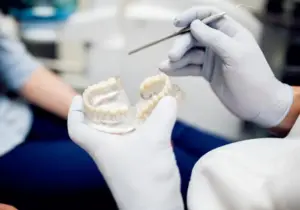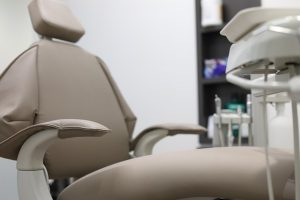Your smile is such an important part of who you are and how you feel about yourself. Naturally, you want to take the best care you can to keep it bright, strong and healthy. But with all the information and misinformation available today over social media and across the internet, you’ve got to be careful with what you believe. Anybody can write an article claiming some new product is life-changing or some viral hack can get you your best smile. But how much of it’s hype and snake oil?
Your teeth are integral to your quality of life and your health; you’ve got to be diligent about researching answers to your questions. Taking your favorite TikToker’s advice might seem like a good idea at the time – but what about 30 years down the road? Take control of your teeth and make sure you’re informed.
To help you get started, here are 10 common myths and misconceptions our patients often ask about that are potentially terrible for your teeth:
Myth #1: Charcoal toothpaste is better than regular toothpaste.
Charcoal is having a moment right now, and charcoal toothpaste has become a popular option by people looking for a more effective whitening toothpaste. However, the same things that make charcoal toothpaste able to dilute surface stains also makes it dangerous for teeth. It’s often too abrasive and can wear enamel down. This will actually cause more stains and lead to tooth sensitivity.
And one thing even the best oral surgeon isn’t going to be able to help you with is restoring ground-down enamel; it’s nearly impossible to rebuild lost enamel, which means eventually the tooth/teeth will need removed and replaced.
Since charcoal absorbs impurities, it can also strip your teeth of necessary minerals they need to replenish themselves. Charcoal toothpaste also reacts with non-tooth material unpredictably, so a dental implant crown or ceramic filling can become discolored and stop matching your surrounding teeth.
So, while charcoal toothpaste is fine every so often for a bit of a whitening boost, it’s in no way better than regular toothpaste. Add the fact that most of these toothpastes don’t contain fluoride either and we argue it’s nowhere near as healthy for your teeth as regular toothpaste.
Myth #2: Zero-sugar soft drinks are better for your teeth.
Dentists hate soda habits as much as nutritionists do. But where diet-wise sugar’s calorie load and nutrient profile are gross, dental health-wise sugar creates the perfect environment for cavity-causing bacteria to thrive in your mouth. So you’d think that if you took the sugar out of the soda, it’d be okay by your dentist, right?
Nope. While fake sugars don’t pose the same risks as real sugar, they’ve got their own issues. Namely, they’re acidic. Like, very acidic. Many even have several different acids in their ingredients list. Studies have shown this low pH can cause equivalent enamel erosion to that of regular sugar. So, while your daily calorie limit might appreciate the switch to diet sodas, your teeth sure won’t.
Myth #3: Pregnant people should avoid the dentist until after birth.
Have you ever heard this old wives’ tale? Many people think any dental work or oral surgery is dangerous during pregnancy, and that no anesthesias for mouth surgery are safe. However, the clinical research to support these ideas just isn’t there. The ADA actually warns against ignoring issues with your teeth and gums until after birth.
Local anesthesias like lidocaine are considered safe, and oral surgeons recommend getting cavities, abscesses and other infections taken care of as soon as possible, as letting these things fester is dangerous to the fetus. The ADA also considers dental x-rays safe during pregnancy, and encourages pregnant women to be even more vigilant about their dental care during this time.
The issue with allowing something like an oral infection like gingivitis or a decayed tooth to go unchecked for the duration of a pregnancy is that no infection solely exists at the site: it’s in your bloodstream. Which means that gross bacteria and low-grade inflammation can have serious implications for prenatal development and neonatal health.
Myth #4: Whiter teeth are healthier than yellowed teeth.
Get ready for this one: the “paper challenge” is both facetious and misleading. Your teeth aren’t supposed to be as white as a sheet of paper or have a creepy blueish tinge in the sunlight, even though that’s the aesthetic right now. Turns out all those jokes about how people from the UK have yellow teeth are kind of silly, because it’s likely their teeth are stronger than our whitened-to-death ones.
A light yellow tinge means your teeth are healthy, and it also likely means they’re stronger and more resilient than their whitened counterparts. Some types of staining may actually be protective. However, all whitening products, to some extent, compromise your enamel. Repeated use and/or overuse can lead to weak, sensitive teeth more prone to decay and, ironically, staining.
Obviously, we’re not talking about super-dark stains, which are signs of underlying issues. But the natural translucency of your enamel, which plays off the yellow of the dentin beneath to create that ivory tooth color is completely natural and, in fact, healthy. White-white teeth are purely a look – they’re not doing anything for your dental health.
Myth #5: Brushing your teeth harder is better for them.
It might seem like simple logic that vigorous brushing gets more plaque and tartar off your teeth, which would mean brushing your teeth hard is good for them. But it’s not so. Like everything, moderation is key. You should be thorough, yes. But you should also be gentle.
Using a toothbrush with hard bristles can wear down your teeth and irritate your gums, even making them bleed. Likewise, brushing too hard – like pressing the bristles into your teeth until they bend or spread – can wear away enamel and even cause gum recession. This leads to sensitive teeth that are susceptible to gingivitis, decay and other infections.
If you brush too hard for too long, eventually the darker parts of your teeth will become visible as your gums peel away, which isn’t only uncomfortable but also a risk to your mouth health. It may eventually lead to needing a tooth or teeth extracted, or even needing gum grafting to correct soft tissue that was worn away by hard brushing. Choose soft-bristled tooth brushes and concentrate on being thorough instead of being aggressive.
Myth #6: It’s normal for your gums to bleed sometimes.
Now, we’ve all bit into something that broke into sharp pieces and made our gums bleed. Or maybe we fumbled the floss and caused a bit of bleeding. That’s fine. The issue is when you have bleeding gums at inappropriate times – they shouldn’t be bleeding at all, outside of those circumstances we mentioned. Even if it’s not necessarily painful, it’s a sign of something else.
Bleeding gums can mean you’ve developed gum disease, another gum infection and/or that your gums are receding. Bleeding gums can also be a sign of other health issues like vitamin K deficiency, Leukemia, hormonal imbalances, and scurvy. When it comes to bleeding gums, you’ll have a gut feeling. If it doesn’t seem normal, it’s probably not, and it’s time to call your dental specialist for a check-in.
Myth #7: Oral health doesn’t affect your overall health.
As we just saw with Myths #3 and #6 – this isn’t true; your mouth isn’t separate from the rest of your body. It’s literally the main gateway between the outside environment and the inside of your body. What does this mean? Say you’ve got a serious amount of plaque buildup on your teeth. Plaque = bacteria. You go to floss and a piece breaks off. You breathe it in. Now you’ve introduced pieces of an infection into your lungs.
Gross, right? The same can be true if you swallow it. Specifically, chronic infections like gingivitis leave you constantly breathing and swallowing bacteria. Oral health is linked to ailments like heart disease, dementia, diabetes, osteoporosis, pneumonia, and birth complications.
Myth #8: Skipping a dental exam is fine if there’s nothing wrong with your mouth.
Yeah, maybe you could get away with it. We’ve seen patients who’ve sheepishly told us they’ve not been to an oral health professional in years, simply because they never had any issues. Honestly, they’re lucky nothing happened. Most of what your dentist visits are for is prevention and early detection of issues.
You can have a cavity and not know it. You can have early-stage gingivitis and be completely unaware. Even scarier, slow-growing cancers can lurk under the surface and in your jaw for months before you’ll feel a symptom. Same with abscesses. Think about it – you skip even one exam and x-ray, and you give those little, easy-to-fix problems an entire year to become big, hard-to-treat problems.
Myth #9: Drinking fluoridated water is bad for you.
There are a couple lines of thought regarding why people think fluoride is bad for you. One, not-science-based idea is that it calcifies your pineal gland. It doesn’t. The other, more legitimate concern, is that overconsumption of fluoride can lead to bone deformations that cause painful, stiff joints and weak bones. But you don’t need to worry – you can’t get that from the water supply.
The public water supply is fluoridated for a reason; healthy levels of fluoride are good for your teeth and bones. In the mid-20th century, the government realized that certain areas with naturally-fluoridated water had significantly lower rates of tooth decay and related issues. They decided to add fluoride to the public water supply across the country and saw rates of childhood tooth loss and decay drastically reduced almost immediately.
Fluoridated water has been carefully regulated by the EPA to remain at safe levels that offer bone and teeth benefits, not dangers. On top of that, states also have to option to further lower those levels, should their constituents find it a cause.
It’s important to note here that meta-analyses of the clinical data has led WHO, US Public Health Service, the NRC and the NHS in the UK to release statements confirming there is no quantifiable link between fluoride and cancer.
Myth #10: Oral x-rays are dangerous.
We get it: x-ray = radiation, and radiation = bad. However, the amount of radiation you’re exposed to during a dental x-ray is so negligible that it’s largely considered safe even for pregnant people. It’s a lower level of radiation than all other related medical scans, it’s a very short exposure time, and you’re protected by partitions.
For reference, it’s estimated people are exposed to over 600 millirems of radiation yearly, more than 50% coming from natural sources and the other 50% from manmade things. According to the US Nuclear Regulatory Commission, it’s safe to be exposed to up to 5000 millirems per year for adults and 500 for children. A CT scan is about 1000 millirems. A dental x-ray? Only 1.5 millirems.
Don’t Believe Everything You Hear About Dental Health
So, yes, the internet is a vast and fascinating place with infinite informational sources. But that doesn’t mean they’re all legit – especially those ads and suggested posts on your social media feeds. Remember that whole “veneers check” where TikTok users ground their teeth down themselves? Or the turkey teeth trend?
It’s important to be properly informed so you can keep your mouth healthy your whole life, and when it comes to your oral health, some things – like charcoal toothpaste – aren’t so black and white. Do your research and, more importantly, check in with your oral surgeon before you jump on the latest dental-health bandwagon.










